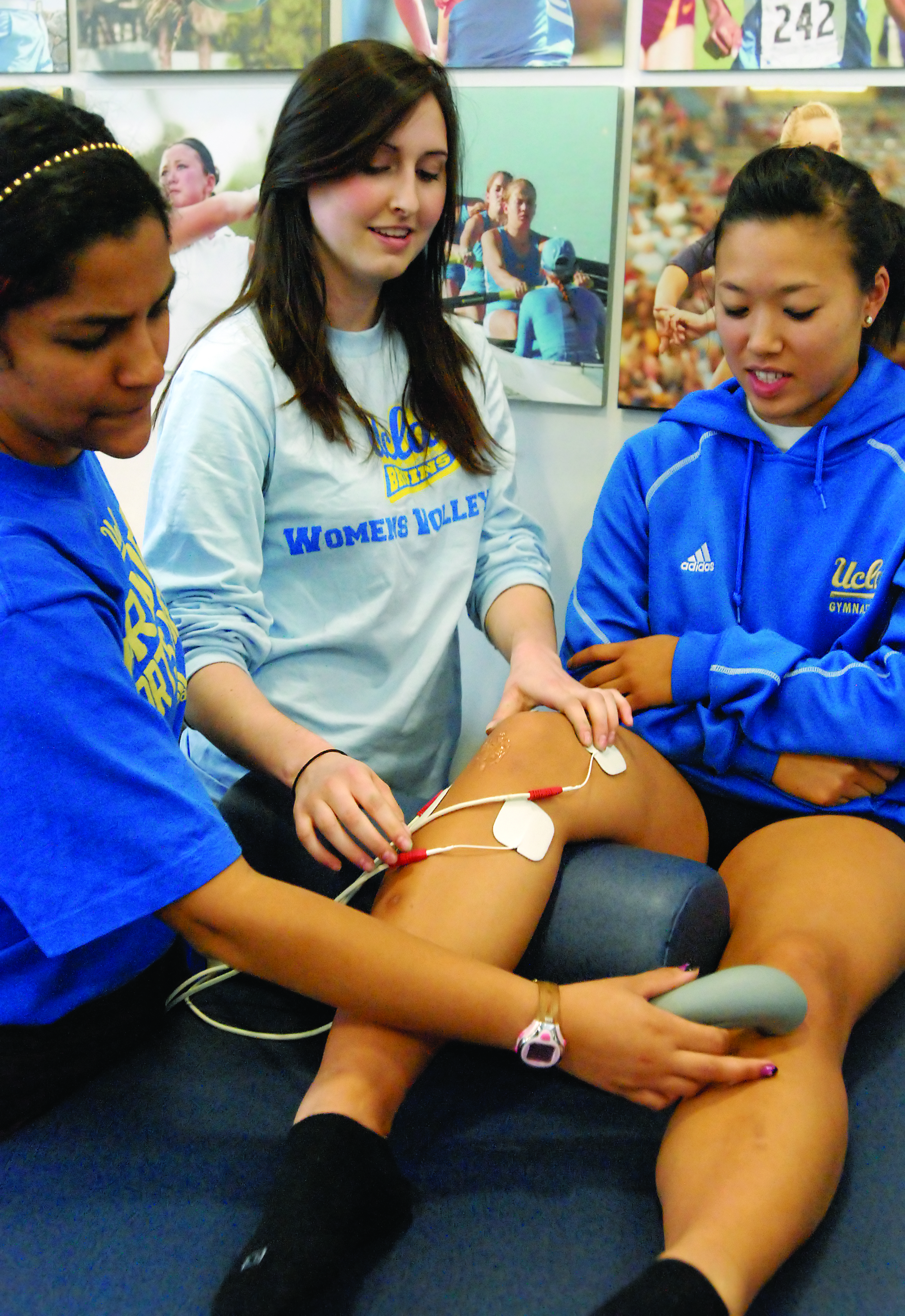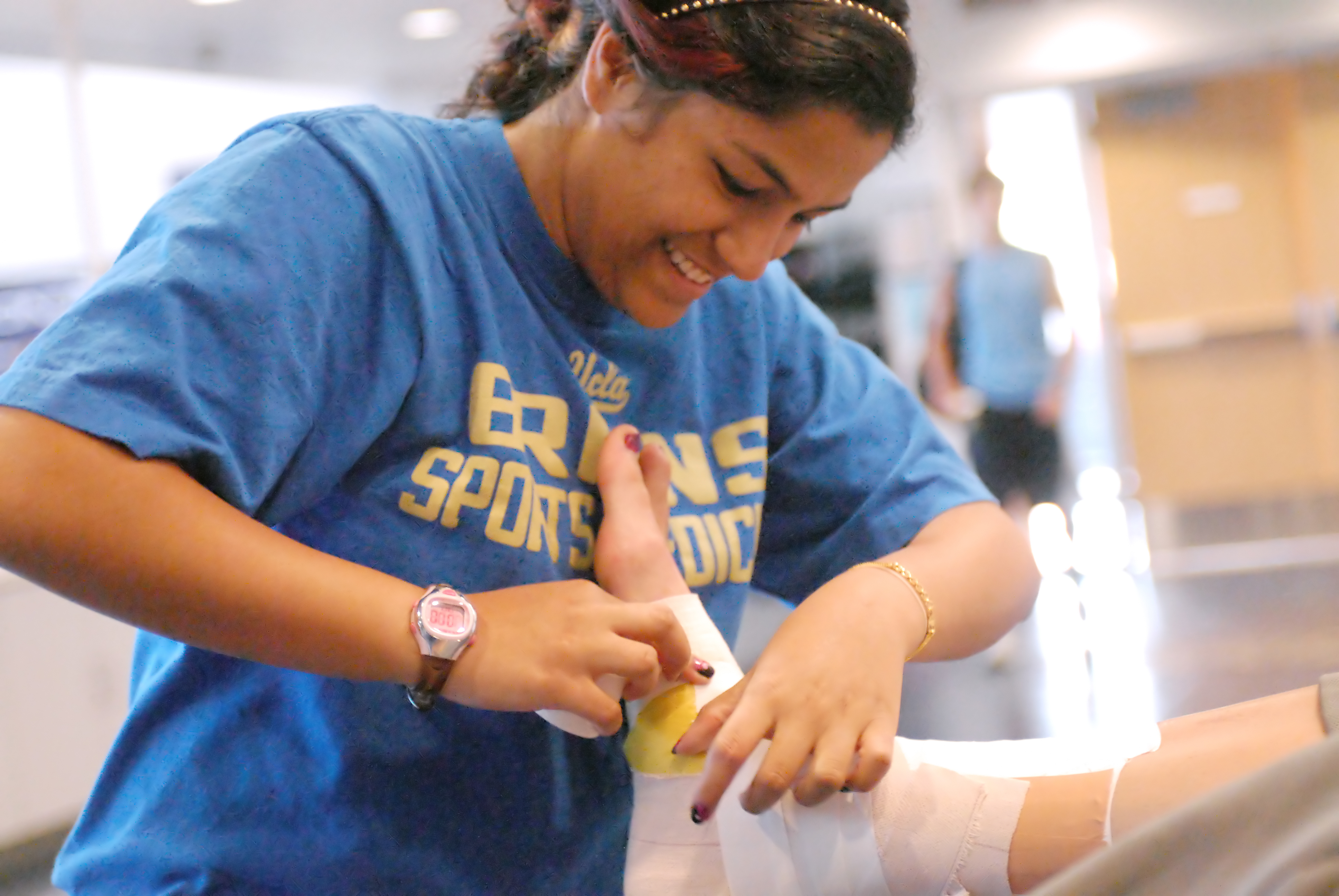
Sonal Singh, left, and Allison Fassett, center, are members of UCLA’s Sports Medicine program.

Sonal Singh, a third-year political science student, practices wrapping an ankle.
Allison Fassett and Sonal Singh can count the entire UCLA women’s volleyball team among their circle of friends. And although they attend every volleyball game, you may not have seen or heard of them before.
There is a good chance, however, of spotting the two students in Acosta Athletic Center’s training and rehabilitation room, working with the players as a part of the athletic department’s Sports Medicine Internship Program.
Fassett and Singh are in their second year of the three-year internship, which is designed to give hands-on training and experience in dealing with basic sports medicine and injuries.
“It’s a lot different than just working in a hospital behind a desk,” Fassett, a third-year psychobiology student, said.
Working at a hospital behind a desk was exactly the kind of internship Fassett had when she decided she wanted a more hands-on experience, she said.
Although she was unsure of what the sports medicine program was about before she applied, she heard through a friend that it would be good preparation for a future career in medicine, she said.
During the first year of the program, the rookie interns take classes on how to treat different sports injuries and get a feel for the varsity sports teams’ medical needs.
As second-year participants of the program, Singh and Fassett chose to work with a specific sports team. Both are working with women’s volleyball this quarter.
They then apply their training for the next two years, whether it’s wrapping a middle blocker’s sprained ankle with medical tape or scraping off scar tissue from the fingers of an outside hitter who may have jammed them while practicing, Singh said.
The program has given Fassett a sense of what her future career could be like, she said.
“This is a lot more of what we intend to be able to do when we get older,” Fassett said.
For instance, outside hitter Bojana Todorovic often needs her left heel taped to treat her chronic plantar fasciitis, an inflammation of the muscles along the bottom of the foot that can affect a player’s ability to run, Fassett said.
The interns also play the role of sports trainer, helping players to build muscle and work on long-term rehabilitation for athletes who need it, she said.
When middle blocker Sara Sage pulled the muscles on the outside of her ankle, Fassett was there with her in the training room, working on side-stepping motions to simulate a real practice or game.
Because each player has a different role on the team, the rehabilitation process is always different, Fassett said.
Seeing the players’ health progress through rehabilitation is part of what makes the internship a rewarding experience, Fassett said.
Interns can spend up to 20 hours per week in the athletic center. In this environment, athletes, interns and trainers all form a closely knit community of people, Singh said.
Singh, who wants to become a sports doctor, has made friends with students who share the same interests and career goals as her, she said.
“It’s like I’ve found another family,” she said.
The interns learn medical terminology to use on the job, something that sets them apart from other undergraduates who are not in the program, Singh said.
“Sometimes it’s embarrassing to talk in front of other people,” Fassett said. “We can sit here and be like “˜Oh, inversion grade one. Ankle sprain, what are we going to do?’ It’s a different type of language.”
The interns also keep contact with orthopedic surgeons and family doctors who work part-time in the center, said Tina Tubbs, assistant athletic trainer at the center.
Even if the interns aren’t interested in sports medicine as a future career, the contacts they make with other doctors through the program makes it all worthwhile, she said.
For Fassett, the program has given her something she couldn’t find anywhere else on campus.
“I honestly feel like I’ve learned more from this program about medicine and what I want to go into than in any class so far at UCLA,” Fassett said.
